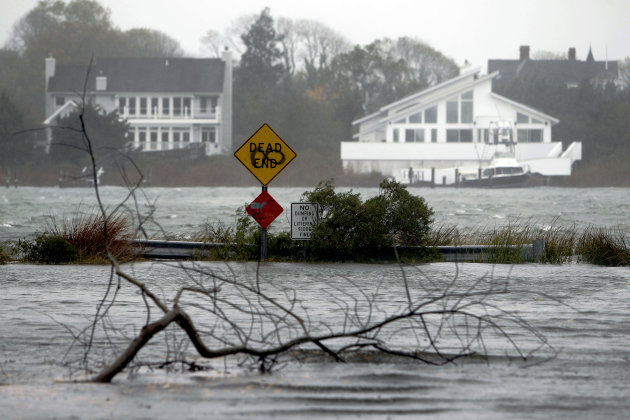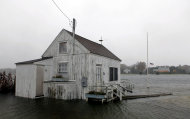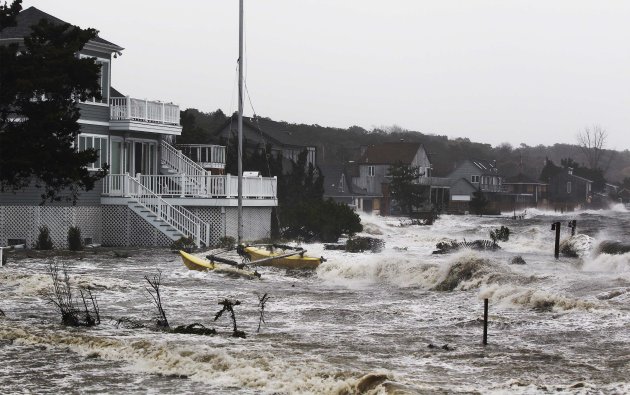Storm
surf kicked up by the high winds from Hurricane Sandy break onto homes
in Southampton, New York October 29, 2012. Hurricane Sandy, the monster
storm
Sandy made its way toward
land, it converged with a cold-weather system out of the west that
turned into a fearsome superstorm, a monstrous hybrid consisting not
only of rain and high wind but of snow. For
ecasters warned of 20-foot
waves bashing into the Chicago lakefront and up to 3 feet of snow in
West Virginia.
Airlines canceled more than
12,000 flights, disrupting the plans of travelers all over the world,
and storm damage was projected at $10 billion to $20 billion, meaning it
could prove to be one of the costliest natural disasters in U.S.
history.
President Barack Obama and
Republican challenger Mitt Romney canceled their campaign appearances at
the very height of the race, with just over a week to go before
Election Day. The president pledged the government's help and made a
direct plea from the White House to those in the storm's path.
"When they tell you to evacuate, you need to evacuate," he said.
"Don't delay, don't pause, don't question the instructions that are
being given, because this is a powerful storm."
Sandy, which killed 69 people in the Caribbean before making its way
up the Atlantic, began to hook left at midday toward the New Jersey
coast.
The storm lost its status as hurricane because it no longer had a
warm core center nor the convection — the upward air movement in the eye
— that traditional hurricanes have, but it was still as dangerous as it
was when it was considered a hurricane, according to National Hurricane
Center spokesman Dennis Feltgen.
Pete Wilson, who owns an antiques shop in Cape May, N.J., at the
state's southern tip and directly in Sandy's path, said the water was 6
inches above the bottom edge of the door. He had already taken a
truckload of antiques out but was certain he would take a big hit.
"My jewelry cases are going to be toast," he said. "I am not too
happy. I am just going to have to wait, and hopefully clean up."
New Jersey Gov. Chris Christie said people were stranded in Atlantic
City, which sits on a barrier island and was mostly under water late
Monday. He accused the mayor of allowing them to stay there.
With the hurricane fast approaching, Christie warned it was no longer
safe for rescuers, and advised people who didn't evacuate the barrier
islands to "hunker down" until morning.
"I hope, I pray, that there won't be any loss of life because of it," he said.
While the hurricane's winds registered as only a Category 1 on a
scale of five, it packed "astoundingly low" barometric pressure, giving
it terrific energy to push water inland, said Kerry Emanuel, a professor
of meteorology at MIT.
"We are looking at the highest storm surges ever recorded" in the
Northeast, said Jeff Masters, meteorology director for Weather
Underground, a private forecasting service. "The energy of the storm
surge is off the charts, basically."
In New York City, authorities
worried that salt water would seep through the boarded-up street grates
and through the sandbags placed at subway entrances, damaging the
electrical connections needed to operate the subway.
Hours before landfall, there was graphic evidence of the storm's power.
A construction crane atop a luxury high-rise in New York City
collapsed in the wind and dangled precariously 74 floors above the
street. Forecasters said the wind at the top the building may have been
close to 95 mph.
Off North Carolina, a replica of
the 18th-century sailing ship HMS Bounty that was built for the 1962
Marlon Brando movie "Mutiny on the Bounty" went down in the storm, and
14 crew members were rescued by helicopter from rubber lifeboats bobbing
in 18-foot seas. Another crew member was found hours later but was
unresponsive. The captain was missing.
At Cape May, water sloshed over the seawall, and it punched through
dunes in other seaside communities. Sandy also tore away an old section
of Atlantic City's historic boardwalk.
"When I think about how much
water is already in the streets, and how much more is going to come with
high tide tonight, this is going to be devastating," said Bob McDevitt,
president of the main Atlantic City casino workers union. "I think this
is going to be a really bad situation tonight."
In Maryland, at least 100 feet of a fishing pier at the beach resort
of Ocean City was destroyed, and Gov. Martin O'Malley said there would
be devastating flooding from the swollen Chesapeake Bay.
"There will be people who die and are killed in this storm," he said.
At least half a million people had been ordered to evacuate,
including 375,000 from low-lying parts of New York City, and by the
afternoon authorities were warning that it could be too late for people
who had not left already.
Millions of people stayed home from work. Sheila Gladden evacuated
her home in Philadelphia's flood-prone Eastwick neighborhood, which took
on 5½ feet of water during Hurricane Floyd in 1999, and headed for a
hotel.
"I'm not going through this again," she said.
Those who stayed behind had few ways to get out. New York's subways,
which serve 5 million people a day, were shut down. The Holland Tunnel
connecting New York to New Jersey was closed, as was a tunnel between
Brooklyn and Manhattan, and the city planned to shut down the Brooklyn
Bridge, the George Washington, the Verrazano-Narrows and several other
spans because of high winds.
Stock and bond markets were closed Monday and Tuesday, the first
shutdown since the days after the Sept. 11 attacks in 2001 and the first
two-day closing of the stock market because of weather since a blizzard
in 1888. The New York Stock Exchange is inside the mandatory evacuation
zone in lower Manhattan, blocks from New York Harbor.
If the storm reaches the higher
estimate of $20 billion in damage, that would put it ahead of Hurricane
Irene, which raked the Northeast in August 2011 and caused $16 billion
in damage. Hurricane Katrina, which killed 1,200 people, cost $108
billion.

 A house is inundated by flood water …
A house is inundated by flood water … A man reacts to waves crashing …
A man reacts to waves crashing …



No comments:
Post a Comment